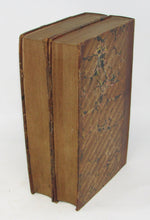
Brande, W. T.; Cauvin, Joseph. A Dictionary of Science, Literature, and Art (2 volume set); Comprising the History, Description, and Scientific Principles of every branch of Human Knowledge; with the Derivation and Definition of all the Terms in General Use. Edited by W. T. Brande, F.R.S.L &E....Assisted by Joseph Cauvin, Esq., the various Departments by Eminent Literary and Scientific Gentlemen. Illustrated by numerous Engravings on Wood. New-York: Harper & Brothers, 1843. First American Edition . [7158]
Two volumes in handsome bindings, leather spines & corners with marbled paper-covered boards, gilt rules to spines, red title labels and black volume labels, all present, lettered in gilt. Outer hinges are fine with light rubbing, no cracks, some light edge-wear elsewhere. 6 1/2 x 9 3/4 inches, iv., 1-672; 673-1352 pp. The wrapper to Part IX. bound in as title page to vol. ii. Rear free end paper of vol. i. with top corner torn away. The pages are foxed, with varying degrees of intensity. A very handsome set. Very good. Hardcover.
William Thomas Brande (1788-1866), English chemist, in 1813 appointed to the chair of Chemistry at the Royal Institution, London; from 1823 was associated with the Royal Mint, the government having consulted Brande on the subject of producing better metal for the use in coin dies. The success of his suggestions led to his appointment as superintendent of the die department. He was a member of several scientific associations, lecturer in chemistry at the Royal Institution, experimenter with Faraday, and was named one of the original fellows of the University of London. "His Dictionary of Science and Art, of which he became the editor in 1842, was a laborious undertaking, supplying a serious want." - see entry at DNB.
This is the true first American edition with the same number of pages as the London edition published the year previous. It was considered to be a scholarly work and as a publishing project it was a success. It was initially issued in 12 parts, with patrons collecting the series and having them bound.



























